Keeping Your Dog's Coat Healthy and Beautiful at Home
One of the money savers often suggested if you have a dog is to do your grooming at home rather than taking the dog to a salon. Whether you do a lot of grooming or just a little to keep your dog looking spiffy between trips to the professional groomer, having the right tools can make all the difference in the world.
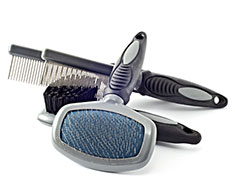
Why brush?
Regular brushing is important because it keeps your dog's coat healthy. Other than feeding a proper diet, brushing is the most important thing you can do to keep your dog's fur and skin in good condition.
Brushing also removes mats and tangles before they become a problem and have to be cut out. When a mat is cut out, you run the risk of nicking the dog's skin, causing unnecessary pain. In some dogs, these minor nicks can even turn into hot spots which are dreadfully painful, as well as unsightly.
Brushing your dog also removes loose dirt and debris from the dog's coat. It may be just the ticket to avoid excessive bathing, which can dry out your dog's skin.
Does your dog shed? Brushing helps to remove all of the loose hair, which will cut down on the amount of fur that ends up on your carpets, clothes, and furniture.
Finally, brushing helps to distribute the natural oils produced by the dog's skin. Spreading these oils out along the entire length of the hair shafts keeps the dog's coat shiny and healthy.
Choosing a Brush
When deciding which brush to use, the most important factor is the type of coat your dog has. Short-haired smooth-coated dogs will do best with brushes that have rounded tips and soft-to-medium bristles that are short and closely spaced. Short-coated wire-haired breeds need firm bristles that are closely spaced. Long-haired dogs may do best with a comb or with a brush that has long, widely-spaced bristles or pins. Dogs with an undercoat may need a special brush to pull out the shedding undercoat without destroying the top coat.
Always buy high-quality grooming tools. Although you'll pay a little more, the dividends will be huge. You won't have to replace the tools as often as you would cheaper ones, and you'll get better results. You should save money by grooming at home anyways, so put some of that savings into a good quality brush or comb. High-quality brushes and combs are less likely to dig into your dog's skin, which makes grooming a fun and pain-free experience that your dog is less likely to resist.
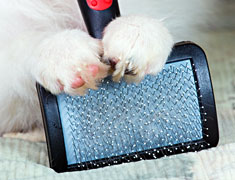
Slicker Brushes
Slicker brushes are usually used on long-coated dogs to cut down on shedding. The slicker brush has a flat base with fine wire pins sticking out of it. Each pin is bent about halfway down the shaft. Slicker brushes come in a variety of sizes and pin stiffness levels. The thicker your dog's coat, the stiffer the pin you will need.
To use a slicker brush, you will have the dog lie down, preferably on a table. Part the dog's hair so you are working with one thin layer at a time. Start near the loose ends of the hair shafts and use short strokes to remove tangles. When the ends are clear, move up the hair shafts a few inches, working your way toward the skin. Once that layer is finished, part the hair up a little higher and work on the next layer. Always brush in the direction the dog's hair grows to prevent pulling.
Pin Brushes
Pin brushes are somewhat similar to slicker brushes, but the pins are not bent. The base of a pin brush is generally oval and made of plastic with a rubber insert holding the pins. The pins should be coated with smooth plastic to protect your dog's coat. If the plastic coating wears off, it's time for a new brush.
Pin brushes are great for detangling long, curly coats, using the same method as described above for slicker brushes. The longer and coarser your dog's coat, the longer pins you will want to have on your brush.
Bristle Brushes
Bristle brushes are usually oval, have a wooden or plastic base, and have (usually) black clumps of bristles sticking out of them. They might remind you of a horse's curry brush.
If you have a long-haired dog, a brush with long, widely-spaced bristles will work best, while short-haired dogs need shorter, tightly-packed bristles.
Bristle brushes are used primarily to remove everyday dust and dirt from your dog's coat.
Some brushes have pins on one side of the head and bristles on the other side, giving you the convenience of using the bristle side for everyday touch-ups and the pin side for more intense weekly grooming. You might also have a dog who has short hair in one area where you might use the bristle side, and longer hair in other areas such as the back and stomach, where you will use the pin brush.
Combs
Combs can be useful in combination with a brush or alone. You might use a comb to separate the layers of your dog's coat for brushing, or you might use it to remove undercoat, work out tangles (particulary when the fur is wet), or to remove dust and dirt.
Most combs are made of metal and have widely spaced teeth at one end and more closely spaced teeth at the other end. Always start with the widely-spaced end to prevent unnecessary pulling of the dog's coat. Once the tangles are removed, you can finish up with the finer end.
Some stores carry combs with very sharp teeth known as dematting combs. These are designed to break up matted fur. You must use these combs with extreme caution as they can easily damage your dog's skin. Hold the fur as close to the skin as you can while you work out the matt. This prevents you from pulling on the dog's skin, which feels like you are trying to pull their hair out. The blades of a dematting comb will dull over time, so you might wish to invest in a comb that has replaceable blades.
A shedding comb (or more properly, a de-shedding comb) has both long and short teeth. The long teeth penetrate to the undercoat, while the short teeth work their magic on the outercoat.
Specialty Brushes
Porcupine brushes have both long and short bristles and are used to remove loose hair from long-coated breeds. They are also well-suited to wire-haired breeds.
The Zoom Groom Brush can be used on wet fur as well as dry, for long- or short-haired breeds. It's a rubberized base with rubber pins sticking out of one side. Made by the Kong company, it is heavy duty and will last a lifetime. The Zoom Groom is used to remove loose hair and to stimulate the dog's skin to encourage the production of oils which keep the fur shiny.
Rubber grooming gloves are gloves that have a nubby rubber palm. You simply massage your dog with the glove on, and it will pull out any loose hair. These are well-suited for short-haired dogs, and can be used whether the fur is wet or dry. Rather than brushing your hand across the dog as you would with a more conventional brush, you massage the dog's coat in a circular motion for best results.
Undercoat rakes are used for dogs with very dense double coats like German Shepherds or Siberian Huskies. These rakes remove loose hair from the undercoat while leaving the top coat shiny. Undercoat rakes are not recommended for short-coated dogs nor for dogs with very long or curly coats. An example of an undercoat rake is the Furminator.
Stripping knives are used to hand-strip a dog's coat. They remove the undercoat while leaving the overcoat intact. There is a knack to using a stripping knife, so it is best to learn from a professional before you try this at home. The basic technique is somewhat similar to using the blade of a pair of scissors to curl a ribbon. You position the knife on the top of a section of fur and place your thumb underneath the section, then draw the knife down through the fur.
Using the right tool for your dog's coat texture will make grooming a pleasant, bonding experience your dog will look forward to. Above all, make sure you are not causing your dog pain while working out mats and tangles.
Doggies Den: Latest Articles
 Homemade Thanksgiving Treats for Your Dog
Homemade Thanksgiving Treats for Your Dog
NUTRITION We all want to include our dogs in our holiday celebrations, but hopefully, you're aware that sharing table scraps with your dog isn't always the best idea.
 Keeping Your Dog Safe during the Summer Months
Keeping Your Dog Safe during the Summer Months
HEALTH Summer is coming on fast, so it’s time to plan how you will keep your dog safe and healthy through the lazy, carefree, warm days.
 Vaccination Time Again-Keeping Your Puppy Healthy
Vaccination Time Again-Keeping Your Puppy Healthy
DOG HEALTH So you have your new puppy picked out. There are quite a few shots, treatments and examinations that will keep the newest member of your family healthy.
 Canine Thanksgiving Feast
Canine Thanksgiving Feast
NUTRITION With the wide variety of food at Thanksgiving dinner, chances are you'll want to give your dog something special, too. If you're contemplating what to feed your dog for the holiday, here is a guide to a great Canine Thanksgiving Feast.
 Dog Walking Tips Every Owner Should Know
Dog Walking Tips Every Owner Should Know
DOG FUN Walking your dog is not only crucial to keeping him healthy and happy, it strengthens the bond between your canine friend and his caregiver. There are a lot of obstacles out there. Don’t forget these simple tips to keep your walk fun and safe in the outside world.
 The Benefits of Physiotherapy for your Dog
The Benefits of Physiotherapy for your Dog
HEALTH The same techniques that physiotherapists use to treat a variety of injuries and conditions in humans have been adapted to suit animals with great success. Family pets, show dogs, and working dogs can all benefit greatly from physiotherapy. Dogs whose activities involve a lot of agility are especially susceptible to the types of problems that physiotherapy can address.
 The Decision- Adding a Dog to Your Family
The Decision- Adding a Dog to Your Family
FIRST TIME OWNERSBringing a dog into your family is a decision where many people don’t realize it’s magnitude until after they have the dog. There are a number of things that you need to research before you decide to purchase a dog, and it starts right in your own home.
 Bringing Your Dog Into Your New Baby's Life
Bringing Your Dog Into Your New Baby's Life
HEALTH Many believe that a dog and a new baby cannot happily coexist, so therefore the dog has to go. This is not necessarily the case. A new baby does not mean you have to abandon your dog.

Doggies Den:
Most Popular Articles

Dog Pregnancy Symptoms
HEALTHIf you suspect your dog might be pregnant, check out part one in this series on pregnant dogs, where we cover pregnant dog symptoms.
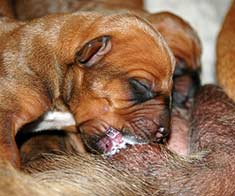
Dog Birth
HEALTHIn the third article of our dog pregnancy series, we look at the wonderful, but messy, process of bringing newborn puppies into the world.

Indoor Dog Potties
DOG PRODUCTSIt's been a long day at work. You were so busy, you didn't even take time to eat a sandwich, let alone run home to let your dog out. You're on your way home, knowing the poor dog is crossing his or her legs by now, when your car breaks down, delaying you even further. Can't somebody make this easier?
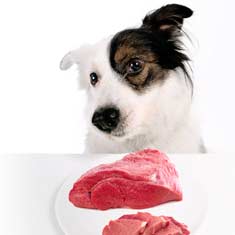
Your Dog’s Digestive System
PHYSIOLOGYEver wonder why your dog eats so fast? Or why he eats gross things? Or why he gets sick to his stomach? Or why his waste stinks so bad? Some of these things are normal, some are not.

Canine Respiratory System
BREATHINGThe basic function of your dog's respiratory system is to bring oxygen in to and remove carbon dioxide from the body. Knowing the symptoms of respiratory diseases can help you help your stay healthy.
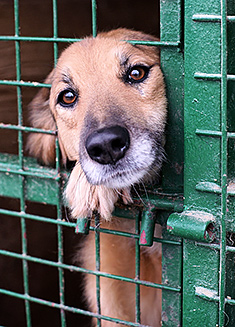
Shelter Dog Adoption Tips for Success
ADOPTION Are you intimidated by the prospect of "rescuing" a dog from a shelter? One reason that you may be wary of adopting a dog from a shelter is not knowing how to choose. Adopting a dog from a shelter can be a rewarding process, if you're prepared to do a reasonable amount of research.

Canine Urinary Tract Infections
SYMPTOMS AND TREATMENTDoes your dog seem to be having trouble relieving his or her bladder? Learn how to recognize the signs of urinary tract infections and how to treat them before they spread.

What to do for Dog Diarrhea
SYMPTOMS AND REMEDIESIf you have dogs in your house for any length of time, you have likely experienced at least one bout of dog diarrhea. Beyond the pain in the tuckus involved in cleaning up the mess, you should know what causes diarrhea, and when it's important to see the vet.
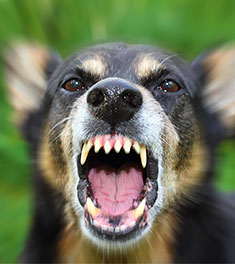
What to do for a Dog Bite
DOG BEHAVIOR Getting bitten by a dog can be scary, and you may be tempted to run around in circles for a while, trying to figure out what to do. Here's our guide to help you manage the situation.

Top Ten Tips for Living with a Senior Dog
DOG HEALTH Bringing home a new puppy is so exciting, but it doesn’t take all that long for your exuberant puppy to grow into a senior dog who may have special needs. Here are the doggies.com top ten tips for taking care of your companion who has been with you through so much.
